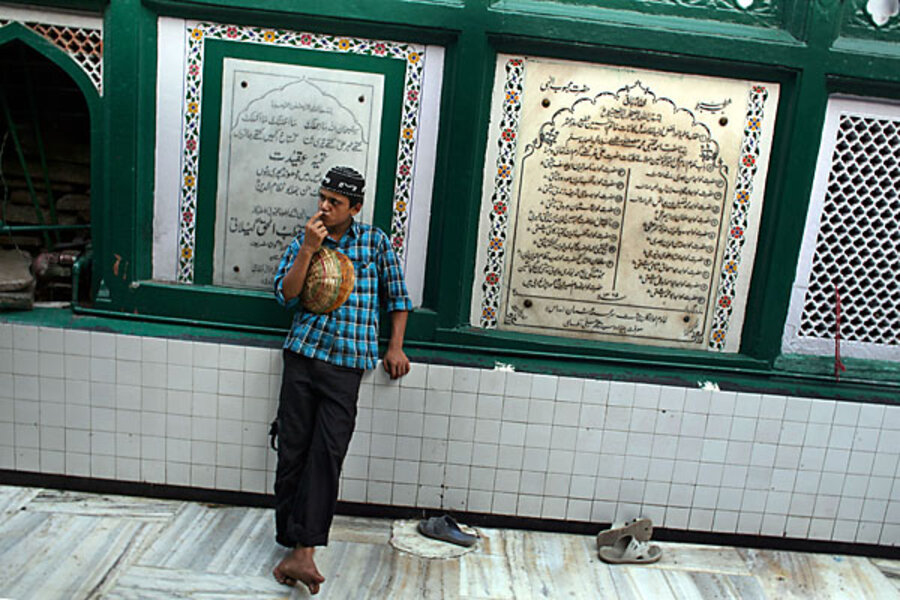India tour: How one impoverished teen helps preserve 700-year-old landmark
| New Delhi
Umair Naqi, a newly minted India tour guide, points to the shabby stone arch that leads into his Delhi neighborhood. The teenager recently discovered that this familiar landmark, at which he had kicked countless balls, was 700 years old – and one of the reasons tourists traipse the lanes around his home, peering at rundown buildings and bewildering the locals.
Mr. Naqi lives in the Hazrat Nizamuddin Basti, a warren of medieval streets that sprang up in the 14th century around the tomb of Hazrat Nizamuddin, India’s most revered Sufi saint. As a Muslim teenager, Naqi knew the tomb was important, but he had no idea that his neighborhood – crammed with old houses, exquisite mosques, and hidden tombs – was one of the most historically significant in India.
He does now. Over the past two years Naqi, with 14 other local young people, has undergone training as a tour guide. The poorly educated youngster has learned English from scratch, studied medieval history, and memorized countless dates and architectural details. He now shows groups of visitors around the basti (an Urdu word meaning settlement) and intends to become a tour guide specializing in Muslim monuments.
“I understand when local people say, ‘What are these people doing here? What is there to see?’ ” says Naqi, the son of a painter, who trips over his new English words in his hurry to point out pillars and porticos. “We didn’t know why people came here either.”
Naqi is part of a a nonprofit-led program to protect India’s historic monuments, but not at the expense of people living among them.
Instead, in an area where most households exist on $100 a month, Naqi’s new language skills and training will make him wealthier than most of his friends, according to Farhad Suri, the local Congress Party councilor and former mayor of Delhi.
“You can talk about heritage, but in a poor area like this there are more pressing problems,” he says. “Without involving local people, by helping them, there would be big local opposition to conservation work.”
Delhi’s endangered heritage
The training project is run by the Aga Khan Trust for Culture (AKTC), which preserves Islamic buildings worldwide. In India, the AKTC has won plaudits for its 2003 restoration of Humayun's Tomb, the bulbous-domed 16th-century precursor to the Taj Mahal, which is one of Delhi’s biggest tourist attractions.
This project is different, because unlike Humayun’s tomb, which stands in its own gated garden, the basti is densely populated.
The AKTC started working in here when part of a large 14th-century step-well, over which a concrete house had been built, collapsed. Other examples of neglect abound. A 14th-century mosque has been refaced with concrete. Several tombs, that have not yet been dated but are thought to be hundreds of years old, are inhabited by extended families.
Delhi is dotted with remnants of its invaders, from the Muslim emperors who ruled it for more than 500 years to the British colonialists who followed. But these monuments are increasingly endangered as more people live right up against – in some cases on top of – precious ruins. As pressure on land and housing grows, property developers are more likely to demolish whatever stands in their way.
Few of India’s heritage buildings are protected by law. The Archaeological Survey of India, a government body, has a list of more than 3,600 protected monuments. But the Indian National Trust for Art and Cultural Heritage, a nongovernmental, nonprofit organization, says there are at least 70,000 old buildings and monuments that should be granted government protection.
Supporting the ruins and residents
Without proper governmental protection of such buildings, the AKTC, in partnership with local government and other NGOs is trying a different approach: to build local support for conservation.
Besides training local youngsters as tour guides, AKTC has funded improvements to the local primary school including the introduction of arts education. It has upgraded a health clinic, set up a pathology laboratory, and built new public toilets.
It is also supporting traditional arts and crafts. “We want to show you can get economic benefits from heritage and that conservation can improve lives,” says Ratish Nanda, the AKTC projects director in India. “The focus is on living heritage.”
That is why, in a tour of 14th-century monuments, Naqi points out goats, halal butchers, and stores selling perfume oil in colored-glass bottles.
But he is also wise to another of the basti’s fascinations. Nizamuddin, like other sufis, taught that love – rather than religious ritual – was the surest route to God. On Thursday nights, when sufi songs are sung in the marble complex housing his tomb, many of the visitors are Hindu – remarkable in a country in which communal discord runs deep.
“All the different religions,” says Naqi. “That’s why the basti is important.”





